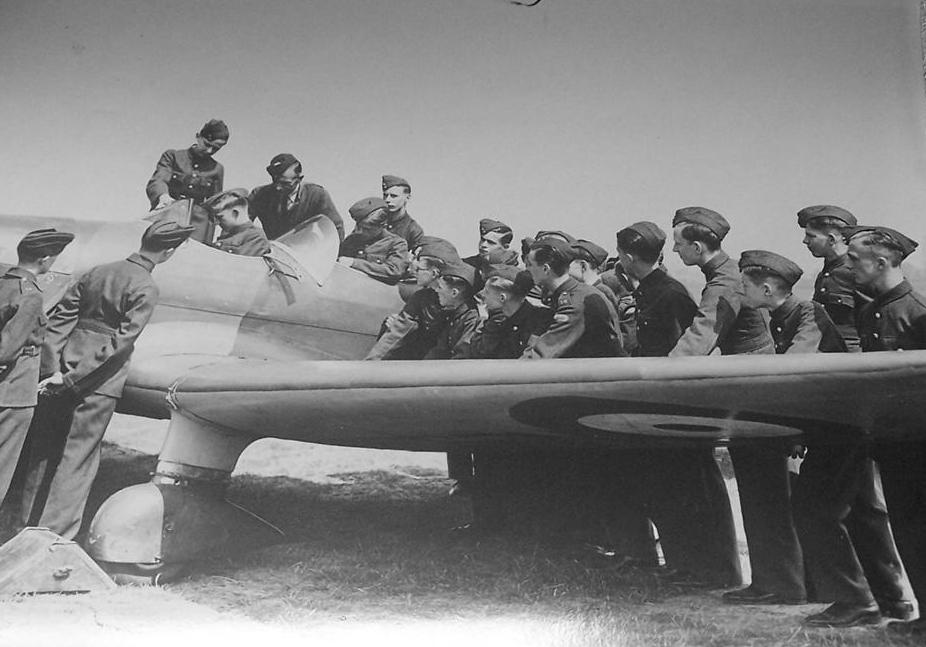
English School Cadet Programs: Services--Royal Air Force

Figure 1.-- Here are some English air cadets during World War II. They are being introduced to the Miles Magister trainer. The press caption read, "Pilots of tomrrow: A visit to ??? ??? ??? Air Training Corps. 500 boys from London ??? ??? ??? one eek, and the camps will be held weekly until ??? ???. Employers are helping bygiving the boys time off. The boys ??? two shillings a day for mssing [food] Allelse is found. Att the ca?? ??? ??? the pilots of tomorrow are tught on first class machines under first class instructors. A class round a Miles Magister machine with a boy the cockpit undr the eyeb of the instructor." The ohotograph was dated October 7, 1941.
|
|
Air Commodore Sir John Chamier was the major force in founding the British Air Cadet Program. Britain entered World War I with an Army and Naval Cadet Program, but no cadet program for the Royal Flying Corps, at the time oat of the Army. It was the foerunner of the Royal Air Force. Chamier served as a pilot in the War and watched many poorly trained young men die withuin in days of being deployed to the front. Flying was one of the mos dangerous military assignments during the War, especially for new pilots. Chamier formally transferred to the Royal Air Force after it was officially constituted (1918). After a decade of post-War service, he retired (1929). He became Secretary-General of the Air League, a private orgianization consisting of individuals desiring to inform the British public about the importance of military aviation. The British like the Americans soon after the euyphoria of victory became disenchanted. Most came to believe that theWar had been a serious mistake. And the losses had been much larger than those suffered by the Americans. The British public was both determined to avoid participating in another War and voted for politicans who supported sharp cuts in military spending. When Hitlerv seized power in Germany and launched a major armaments program, this soon put the Allies (Britain and France) behind in defense preparation and arms development. (France experienced the ame polityical process as in Britain.) Air Commodore Chamier, concerned about German rearmament and recalling the terrible tragedy of poorly tarined young pilots being shot down by experienced German pilots, decided that Britain needed an air cadet corps in addition of the army and naval program. Chamier help found the Air Defence Cadet Corps (ADCC) (1938). The idea was to train youth in aviation skills. [MOD] The ADCC proved popular and thousands of youth joined, but facikities including glides and training air craft were very limited because if thesubstantial costs involved. Unfortunately for Britain, the Germans had begun this process earlir and with extensive Government support--The Flieger HJ. As a result, the Germans began the war with a much larger pool of trained aviators and youth with aviation skills. Goverment support for the effort did not begin until after the start of the War and the Battle of Britain. As it evolved, the RAF almost lost the Battle of Britain because of the shortage not of aircraft but of trained pilots. King George VI by Royal warrant finally turned the ADCC into an offical cadet program (1941). The ADCC organized beginning air training to teenagers below military age who were interested in joining join the Royal Air Force.
Sources
"General Service Training, Section 1 - The Air Training Corps", Air Cadet Publication No. 31 (Lincolnshire: Air Cadet Organization, 2000).
Ministry of Defence (MOD). "About Defence - What we do - Reserve Forces and Cadets - DRFC - History of the Cadet Forces" (Ministry of Defence).
HBC

Navigate the HBC Cadet Pages
[Return to the Main English Cadet services page]
[Return to the Main English Cadet page]
[Return to the Main Cadet page]
[Australia]
[New Zealand]
[Russia]
[Scotland]
[South Africa]
[United States]
Navigate the Historic Boys' Clothing Web Site:
[Return to the Main military page]
[Introduction]
[Activities]
[Biographies]
[Chronology]
[Cloth and textiles]
[Clothing styles]
[Countries]
[Topics]
[Bibliographies]
[Contributions]
[FAQs]
[Glossaries]
[Images]
[Links]
[Registration]
[Tools]
[Boys' Clothing Home]
Created: 1:16 AM 12/11/2013
Last updated: 1:16 AM 12/11/2013



